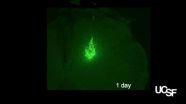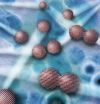(Press-News.org) GENE THERAPY
Gene therapy can correct forms of severe combined immunodeficiency
Severe combined immunodeficiency is defect in the immune system that results in a loss of the adaptive immune cells known as B cells and T cells. Mutations in several different genes can lead to the development of severe combined immunodeficiency, including mutation of the adenosine deaminase (ADA) gene. Traditional treatment options, such as enzyme replacement therapy, are of limited efficacy, but bone marrow transplant from a compatible donor leads to a better response. A recent clinical trial indicated that gene therapy to insert the correct ADA gene in the patient's own bone marrow cells can also lead to a good response. However, patients were noted to have defects in B cell tolerance, meaning that some B cells that react to antigens from the body fail to be eliminated, leading to an autoimmune response. Dr. Eric Meffre and colleages at Yale University in New Haven, Connecticut and Alessandro Aiuti in Milan, Italy joined together to better understand why patients developed B cell tolerance problems. They found that loss of the ADA gene directly contributes to B cell tolerance problems and that these defects are mostly corrected after gene therapy. Their results point to a previously unknown role for ADA in B cell response and support the use of gene therapy as an effective treatment option for ADA-deficient severe combined immunodeficiency patients.
TITLE:
Defective B cell tolerance in adenosine deaminase deficiency is corrected by gene therapy
AUTHOR CONTACT:
Eric Meffre
Yale University School of Medicine, New Haven, CT, USA
Phone: 203-737-4535; Fax: 203-785-7903; E-mail: eric.meffre@yale.edu
View this article at: http://www.jci.org/articles/view/61788?key=360dfcf9a3df9017a2e0
ACCOMPANYING COMMENTARY
TITLE:
Restoring balance to B cells in ADA deficiency
AUTHOR CONTACT:
Eline Luning Prak
University of Pennsylvania, Philadelphia, PA, USA
Phone: 215 746 5768; E-mail: luning@mail.med.upenn.edu
View this article at: http://www.jci.org/articles/view/63782?key=0526bdd0f63367a6184b
VASCULAR BIOLOGY
A change in fate: lymphatic vessels reprogrammed to blood vessels
Blood circulation requires the vascular system, the vast network of arteries and veins through which blood is pumped. In a parallel network, known as the lymphatic system, lymph fluid, which contains a mixture of immune cells, bacteria, fat, and other debris, is circulated through specialized lymphatic vessels. The lymphatic system plays a critical role in helping the immune system fight off foreign pathogens in the body. Though the development of lymphatic vessels and blood vessels is completely separate in the body, researchers at the University of Pennsylvania in Philadelphia recently uncovered a novel mechanism that distinguishes whether vessels have a lymphatic or vascular fate. Led by Dr. Mark, Kahn, the research team found that mice lacking the signaling protein SLP76 have blood rather than lymph flowing through lymphatic vessels. By looking closely at the vessels, they showed that the endothelial cells lining the vessels were reprogrammed to assume a vascular fate. Further, they found that the presence of blood per se did not induce the change to blood vessels, but rather the sheer force caused by blood flow induced the transformation. Blood flow caused a decrease in the transcription factor PROX1, which is required to specify cells to the lymphatic fate. Their results uncover for the first time the role of fluid dynamics in determining endothelial cell identity.
TITLE:
Blood flow reprograms lymphatic vessels to blood vessels
AUTHOR CONTACT:
Mark L. Kahn
University of Pennsylvania, Philadelphia, PA, USA
Phone: (215) 898-9007; E-mail: markkahn@mail.med.upenn.edu
View this article at: http://www.jci.org/articles/view/57513?key=f79d133d33c1137dd664
VACCINE DESIGN
A new strategy for developing meningitis vaccines
Bacterial meningitis is an infection of the meninges, the protective membrane that covers the spinal cord and brain. Children, elderly patients and immunocompromised patients are at a higher risk for the development of severe bacterial meningitis. Recently, researchers at the University of Adelaide in Australia sought to identify new vaccine targets in Streptococcus pneumoniae, which is the most common cause of bacterial meningitis in the world. Led by Dr. Abiodun Ogunniyi, the research team developed a new method of screening for bacterial genes that are expressed during meningitis in brain tissue. Using a mouse model system, the researchers examined mice infected with two different strains of S. pneumoniae. They identified a protein known as glycerophosphate oxidase, and showed that this protein was critical for the progression of bacteria from blood to brain in mice. They went on to show that a vaccine against glycerophosphate oxidase protected mice from invasive pneumococcal disease. Their results not only suggest a new strategy for immunizing against Streptococcus pneumoniae, but also provide a blueprint for discovering additional genes from other pathogens contribute to meningitis.
TITLE:
Identification of a novel pneumococcal vaccine antigen preferentially expressed during meningitis in mice
AUTHOR CONTACT:
Abiodun Ogunniyi
Research Centre for Infectious Diseases, Adelaide, SA, AUS
Phone: +61 8 8303 7550; Fax: +61 8 8303 7532; E-mail: david.ogunniyi@adelaide.edu.au
View this article at: http://www.jci.org/articles/view/45850?key=fe305b8454eb8b1b3857
ONCOLOGY
Marked for destruction: newly developed compound triggers cancer cell death
The BCL-2 protein family plays a large role in determining whether cancer cells survive in response to therapy or undergo a form of cell death known as apoptosis. Cells are pressured toward apoptosis by expression of pro-apoptotic BCL-2 proteins. However, cancer cells respond to therapy by increasing expression of anti-apoptotic proteins, which bind and neutralize pro-apoptotic family members and mediate therapeutic resistance. Therefore, development of therapeutic strategies to neutralize resistance to apoptosis will be critical to clinical improvements. A research group from the Dana-Farber Cancer Institute, led by Dr. Loren Walensky, developed a compound modeled directly from the pro-apoptotic the death domain of BCL-2, the BIM BH3 domain. This compound, known as a stapled BIM BH3 peptide, was found to competitively bind with anti-apoptotic proteins and led to enhanced apoptosis in cancer cells. They also showed that tumor growth in mice was suppressed by the stapled BIM BH3 compound and that the new compound worked synergistically with other with pharmaceutical agents that promote apoptosis. The potential therapeutic effects of stapled BIM BH3 were further shown by activation of cell death in an acute myeloid leukemia tumor model in mice with little side effects on surrounding tissue. Their study presents a new formulation of a BH3 mimetic that has broad BCL-2 family targeting and may provide significant clinical benefit.
TITLE:
A stapled BIM peptide overcomes apoptotic resistance in hematologic cancers
AUTHOR CONTACT:
Loren Walensky
Dana-Farber Cancer Institute, Boston, MA, USA
Phone: 617-632-6307; Fax: 617-582-8240; E-mail: loren_walensky@dfci.harvard.edu
View this article at: http://www.jci.org/articles/view/46231?key=efeef72c575c4352c2f1
ACCOMPANYING COMMENTARY
TITLE:
Therapeutic potential of a peptide targeting BCL-2 cell guardians in cancer
AUTHOR CONTACT:
Jerry Adams
The Walter & Eliza Hall Institute, Melbourne, UNK, AUS
Phone: 61-3-93452491; Fax: 61-3-93470852; E-mail: adams@wehi.edu.au
View this article at: http://www.jci.org/articles/view/64120?key=be6249d4046e82d4e494
VASCULAR BIOLOGY
Newly identified microRNA regulates vascular inflammation
Inflammation is one way the body fights off infections and foreign invaders, but it is also widely known to be associated with a number of chronic and short-term conditions, including diabetes, heart disease, and sepsis. Understanding how complex inflammatory processes are controlled is critical to finding new ways to treat and control the progression of these illnesses. Activation of a transcription factor known as NF-kB is central to the inflammatory process, resulting in expression of a number of genes that mediate the inflammatory response and promote recruitment of white blood cells to sites of inflammation. A new study led by senior author Dr. Mark Feinberg and colleagues at Harvard Medical School reveals a critical component of this pathway: miR-181b, a regulatory microRNA that potently regulates early inflammatory signaling processes. By examining inflammation that occurs in vascular endothelial cells, the specialized cells that line blood vessels, the Feinberg team found that miR-181b expression is decreased in a mouse model of lung inflammation. They also showed that forced overexpression of miR-181b during inflammation resulted in decreased inflammation-related gene production and a reduction in inflammatory lung injury. Further, miR-181b expression reduced the activation of the pro-inflammatory signaling protein NF-κB, which ultimately led to decreased vascular inflammation. Their findings suggest that miR-181b is a key inhibitor of the inflammatory response in mice. In the accompanying commentary, Drs. Jason Fish and Myron Cybulsky note that microRNAs such as miR-181b may be exciting and attractive targets for future vascular inflammatory disease therapeutics.
TITLE:
MicroRNA-181b regulates NF-κB–mediated vascular inflammation
AUTHOR CONTACT:
Mark W. Feinberg
Brigham and Women's Hospital and Harvard Medical School, Boston, MA, USA
Phone: 617-525-4381; Fax: 617-525-4380; E-mail: mfeinberg@rics.bwh.harvard.edu
View this article at: http://www.jci.org/articles/view/61495?key=eb1736578b75edd22504
ACCOMPANYING COMMENTARY
TITLE:
Taming endothelial activation with a microRNA
AUTHOR CONTACT:
Myron I. Cybulsky
Toronto General Research Institute, Toronto, ON, CAN
Phone: 416-581-7483; Fax: 416-581-7484; E-mail: myron.cybulsky@utoronto.ca
View this article at: http://www.jci.org/articles/view/63818?key=2851926238c2a8d868e9
ONCOLOGY Cancer stem cells self-renewal capacity is independent of their ability to initiate leukemia | Back to top
In leukemia, specialized cells called cancer stem cells are thought to proliferate to generate tumor cells. These cancer stem cells are rare in the tumor population and have unique properties from other tumor cells, including increased resistance to conventional drug therapy. Defects in regulating the mammalian target of rapamycin mTOR complex 1 (mTORC1), formed by several proteins including mTOR and Raptor, are common in leukemia. Although ablation of mTOR and Raptor have shown that mTORC1 is indispensable for normal cell proliferation and survival during embryogenesis, the role of mTORC1 in cancer stem cells and established leukemia is unclear. In this issue, Atsushi Hirao and colleagues from Kanazawa University in Japan have demonstrated in adult mice that Raptor deficiency impairs granulocyte and B cell development without affecting normal hematopoietic progenitor cell survival or proliferation. Furthermore, in a model of acute myeloid leukemia, mTORC1 inactivation by Raptor deficiency does not affect the ability of cancer stem cells to self-renew but halts their capacity to initiate leukemia. Reactivation of mTORC1 restores the leukemia-initiating capacity of these cancer stem cells. Their findings are unique in showing that the ability of cancer stem cells to self-renew is different from the capacity to initiate and propagate tumors. Accounting for this difference can significantly impact future studies geared towards improved therapeutic strategies to target cancer cells resistant to conventional treatment.
TITLE:
mTORC1 is essential for leukemia propagation but not stem cell self-renewal
AUTHOR CONTACT:
Atsushi Hirao
Kanazawa University Cancer Research Institute, Kanazawa, , JPN
Phone: 81-76-264-6755; E-mail: ahirao@staff.kanazawa-u.ac.jp
View this article at: http://www.jci.org/articles/view/62279?key=be835561d3a7b544294f
ACCOMPANYING COMMENTARY
TITLE:
Getting to the finish line with mTORC1-targeted therapy
AUTHOR CONTACT:
Elizabeth Henske
Dana Farber/Harvard Cancer Center, Boston, MA, USA
E-mail: ehenske@partners.org
View this article at: http://www.jci.org/articles/view/64227?key=7296b3a8003d2a59e1a9
ONCOLOGY Telomere stability and carcinogenesis: an off-again, on-again relationship
Previous studies in mice have demonstrated antagonistic effects of telomerase loss on carcinogenesis. Telomere attrition can promote genome instability thereby stimulating initiation of early-stage cancers, but can also inhibit tumorigenesis by promoting permanent cell growth arrest or death. Human cancers likely develop in cell lineages with low levels of telomerase, leading to telomere losses in early lesions, followed by subsequent activation of telomerase. Mouse models constitutively lacking telomerase have thus not addressed how telomere losses within telomerase-proficient cells impact carcinogenesis. Using a novel transgenic mouse model, Begus-Nahrmann et al. demonstrate in this issue of the JCI that transient telomere dysfunction in telomerase-proficient animals is a potent stimulus of tumor formation.
COMMENTARY TITLE:
Telomere stability and carcinogenesis: an off-again, on-again relationship
COMMENTARY AUTHOR CONTACT:
Brad Johnson
University of Pennsylvania, Philadelphia, USA
Phone: 215 573-5037; E-mail: johnsonb@mail.med.upenn.edu
View this article at: http://www.jci.org/articles/view/63979?key=e733179cf3470c467d55
RESEARCH ARTICLE TITLE
Transient telomere dysfunction induces chromosomal instability and promotes carcinogenesis
RESEARCH AUTHOR CONTACT:
Lenhard Rudolph
University of Ulm, Ulm, UNK, DEU
Phone: 0049-162-25-23741; Fax: 0049-731-50-36102; E-mail: lenhard.rudolph@uni-ulm.de
View this article at: http://www.jci.org/articles/view/61745?key=a20b616ef5a4a31806ec
### END
JCI early table of contents for May 24, 2012
2012-05-28
ELSE PRESS RELEASES FROM THIS DATE:
A boost in microRNA may protect against sepsis and other inflammatory diseases
2012-05-28
BOSTON, MA—Acute inflammatory diseases, such as sepsis, as well as chronic inflammatory diseases like diabetes and arthritis, develop as a result of sustained inflammation of the blood vessel wall. Researchers at Brigham and Women's Hospital (BWH) have discovered that a microRNA (small, non-coding RNA molecule) called miR-181b can reduce the inflammatory response that is responsible for such diseases.
The findings, by researchers led by Mark Feinberg, MD from BWH and Harvard Medical School, will pave the way for new targets in the development of anti-inflammatory therapies. ...
Nuisance seaweed found to produce compounds with biomedical potential
2012-05-28
A seaweed considered a threat to the healthy growth of coral reefs in Hawaii may possess the ability to produce substances that could one day treat human diseases, a new study led by scientists at Scripps Institution of Oceanography at UC San Diego has revealed.
An analysis led by Hyukjae Choi, a postdoctoral researcher in William Gerwick's laboratory at Scripps, has shown that the seaweed, a tiny photosynthetic organism known as a "cyanobacterium," produces chemical compounds that exhibit promise as anti-inflammatory agents and in combatting bacterial infections. The ...
Chronic pain is relieved by cell transplantation in lab study
2012-05-28
Chronic pain, by definition, is difficult to manage, but a new study by UCSF scientists shows how a cell therapy might one day be used not only to quell some common types of persistent and difficult-to-treat pain, but also to cure the conditions that give rise to them.
The researchers, working with mice, focused on treating chronic pain that arises from nerve injury -- so-called neuropathic pain.
In their study, published in the March 24, 2012 issue of Neuron, the scientists transplanted immature embryonic nerve cells that arise in the brain during development and ...
Gourmet butterflies speed north
2012-05-28
A new study led by scientists in the Department of Biology at the University of York has shown how a butterfly has changed its diet, and consequently has sped northwards in response to climate change.
Their study is published in the latest issue of Science.
The researchers found that warmer summers have allowed the Brown Argus butterfly to complete its life cycle by eating wild Geranium plants. Because the Geraniums are widespread in the British countryside, this change in diet has allowed the butterfly to expand its range in Britain at a surprisingly rapid rate. Over ...
The cells' petrol pump is finally identified
2012-05-28
Our cells breathe and digest, as does the organism as a whole. They indeed use oxygen to draw the energy contained in the nutrients they ingest, before discarding the waste, as carbon dioxide and water. Glucose is a preferred nutrient for the cells. Its digestion occurs in the cytoplasm, in the absence of oxygen, and leads to the formation of pyruvate and a small amount of energy. Pyruvate is then carried into mitochondria, the cell's power plants, for a complete burning, thus providing a maximal energetic yield.
A mediocre energetic yield in tumor cells
'As opposed ...
CWRU class earns Science magazine prize for innovation
2012-05-28
Science magazine has awarded a prize for Inquiry-Based Instruction to a Case Western Reserve University class that melds biology, computer modeling, mathematical analysis and writing.
"Dynamics of Biological Systems," taught by Biology Professor Hillel Chiel and three graduate assistants, abandons traditional lectures altogether in favor of learning by doing. The teachers call the class an example of the use of the continual improvement model in education.
In it, Chiel pairs biology majors with engineering, physics or math majors, and has them concentrate on building ...
First direct observation of oriented attachment in nanocrystal growth
2012-05-28
Through biomineralization, nature is able to produce such engineering marvels as mother of pearl, or nacre, the inner lining of abalone shells renowned for both its iridescent beauty and amazing toughness. Key to biomineralization is the phenomenon known as "oriented attachment," whereby adjacent nanoparticles connect with one another in a common crystallographic orientation. While the importance of oriented attachment to biomineral properties long has been recognized, the mechanism by which it occurs has remained a mystery. With a better understanding of oriented attachment ...
Nanoparticles seen as artificial atoms
2012-05-28
VIDEO:
Berkeley Lab researchers at the National Center for Electron Microscopy recorded real-time observations of nanocrystal growth that support the theory of nanoparticles acting like artificial atoms. This electron microscopy movie...
Click here for more information.
In the growth of crystals, do nanoparticles act as "artificial atoms" forming molecular-type building blocks that can assemble into complex structures? This is the contention of a major but controversial ...
Knowing genetic makeup may not significantly improve disease risk prediction
2012-05-28
Boston, MA —Harvard School of Public Health (HSPH) researchers have found that detailed knowledge about your genetic makeup—the interplay between genetic variants and other genetic variants, or between genetic variants and environmental risk factors—may only change your estimated disease prediction risk for three common diseases by a few percentage points, which is typically not enough to make a difference in prevention or treatment plans. It is the first study to revisit claims in previous research that including such information in risk models would eventually help doctors ...
Pivotal role for proteins -- from helping turn carbs into energy to causing devastating disease
2012-05-28
(SALT LAKE CITY)—Research into how carbohydrates are converted into energy has led to a surprising discovery with implications for the treatment of a perplexing and potentially fatal neuromuscular disorder and possibly even cancer and heart disease.
Until this study, the cause of this neuromuscular disorder was unknown. But after obtaining DNA from three families with members who have the disorder, a team led by University of Utah scientists Jared Rutter, Ph.D., associate professor of biochemistry and Carl Thummel, Ph.D., professor of human genetics, sequenced two genes ...


